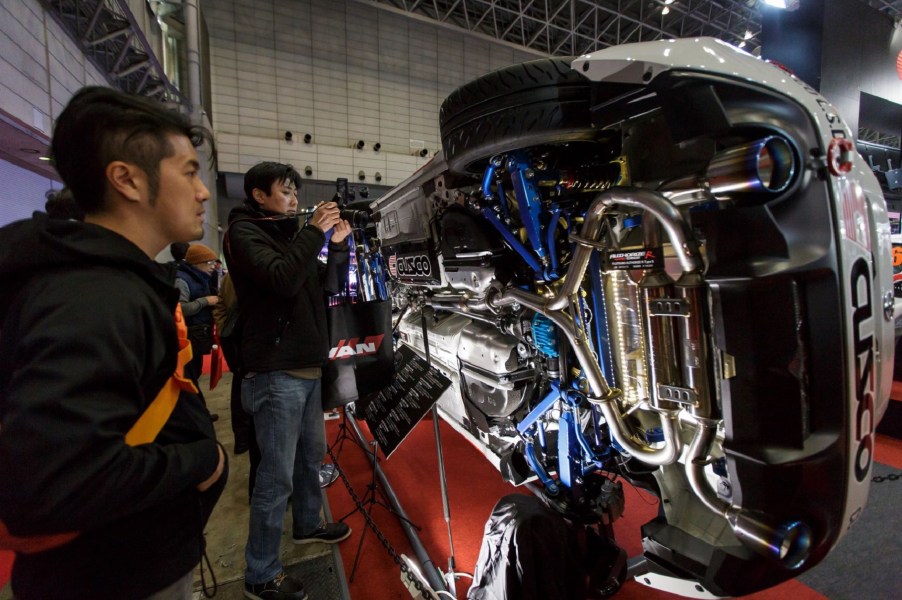
Do Performance Exhausts Really Increase Horsepower?
Improving the airflow to a car’s engine is one of the first, and often easiest, modifications many enthusiasts make. Another common mod is giving your car an aftermarket performance exhaust. Many OEMs, such as Ford, GM, and Toyota, even offer them as factory accessories. But does giving your car a ‘performance’ exhaust really do anything?
What is a performance exhaust meant to do?
Technically, CarThrottle explains, your car’s exhaust is comprised of several parts. Starting at the engine, there’s the exhaust manifold—or headers, if you’ve swapped them in—the downpipe, the resonator, the catalytic converter, and the muffler.
Typically, though, the term ‘performance exhaust’ refers to the section that contains the ‘cat’ and the muffler. That’s why some aftermarket exhausts are called ‘cat-back’ exhausts, AutoAnything explains: because they replace the piping after the catalytic converter.
As with cold-air intakes and headers, the goal of a performance exhaust is to de-restrict airflow and increase engine output, Vivid Racing explains. And primarily, that’s by improving scavenging, The Drive explains.
Air moves into and out of the combustion chamber when the intake and exhaust valves open and close. But if your car’s exhaust is too restrictive, the exhaust gases can spill back in due to back-pressure in the piping. This reduces available oxygen and decreases horsepower.
The best performance exhausts, though, are designed not just to reduce back-pressure, but create partial vacuums, Road & Track explains. So not only are the exhaust gases flowing more quickly, they’re actually being sucked, or ‘scavenged,’ out. Now the combustion chamber has more oxygen, which means the engine makes more power.
At least, in theory.
How much power does a performance exhaust add?
Both Donut Media and Engineering Explained have fit performance exhausts to their vehicles. Specifically, to their naturally-aspirated vehicles. And the results, like Donut Media experienced with the cold-air intake and aftermarket headers, were relatively minor.
Donut Media’s host Zach Jobe didn’t notice any power difference in his Miata. And even after fitting new headers and an aftermarket intake, the Miata only gained about 4 hp. Arguably, the biggest reason why Jobe fitted a new car exhaust is to improve the Miata’s sound quality.
It’s a similar situation with Engineering Explained’s host Jason Fenske and his Honda S2000. Outfitted with a titanium cat-back exhaust, the S2000 only gained about 3 hp. Plus, most of the gain was in higher RPMs—great for track driving, not as useful on the street. Though, as with Jobe, Fenske did appreciate the sound improvement.
However, both the Miata and S2000 are naturally-aspirated. If they’d been turbocharged, the performance exhausts may have made a bigger difference. As D Sport Mag explains, forced-induction engines practically require as free-flowing an exhaust as possible because of how they work. Less back-pressure means the turbos can spool up even faster, AutoZone explains. It matters less for superchargers because they use the crankshaft to spool up, not exhaust gases. However, a less-restrictive car exhaust would still maximize the supercharger’s benefits.
Other things to consider

If you do plan on giving your car an aftermarket performance exhaust, there are a few more things worth noting.
Firstly, depending on where you live, your new, louder car exhaust may actually be breaking the law. The larger pipes mean your car makes more noise, and some communities have decibel restrictions. And even if they don’t, your neighbors might not appreciate the MagnaFlow you installed in your Mustang.
Secondly, some performance exhausts remove the catalytic converter completely. For race cars or off-road-only vehicles, that’s not an issue. But it is a major problem if you want to drive your car on public roads because tampering with emissions equipment is a felony. Fortunately, there are emissions-legal high-flow catalytic converters available, and some aftermarket exhausts come bundled with them.
Finally, consider investment vs. performance gained. Fenske paid $2500 for his S2000’s exhaust, and only added 3 hp. If the car was turbocharged, he might’ve gained more. But it is something to keep in mind if you’re thinking about upgrading your car’s exhaust. Aftermarket systems do add horsepower, but for naturally-aspirated cars, the improvements are fairly minimal.
Follow more updates from MotorBiscuit on our Facebook page.


